The US yard of Keppel Offshore & Marine delivered the 2,525 teu, LNG-powered, George III, built to a propriety design by the Singapore-headquartered group.
A second vessel the Janet Marie is currently under construction at the yard and the two containerships will be the first LNG-powered vessels to serve the US West Coast. They will be deployed by Pasha Hawaii on the Hawaii – US mainland Jones Act trade.
George III is also the first IGF compliant vessel certified by the United States Coast Guard.
David Wedgeworth, President of Keppel AmFELS, said, “We are pleased to deliver Pasha Hawaii’s first LNG-powered containership, which extends Keppel O&M’s track record in providing solutions for the gas value chain. By working closely with Pasha Hawaii, we were able to resolve operational challenges posed by Covid-19 and deliver the vessel to their satisfaction.
George Pasha, IV, President and CEO of The Pasha Group, said, “We look forward to beginning service to Hawaii in August and taking delivery of the Janet Marie later this year.”
Keppel AmFELS’ Wedgeworth added: “We are supporting the Jones Act market and are currently building Pasha Hawaii’s second LNG-fuelled containership, as well as other vessels for the offshore wind and dredging sectors.”
The Texas yard is building a wind turbine installation vessel in the US for Dominion Energy, as well as a high-specification Trailing Suction Hopper Dredger for Manson Construction.
Keppel Offshore & Marine is in the process of finalising a merger with its Singapore compatriot and rival yard group Sembcorp Marine, and returned to the black in the first half of 2022.
Source: https://www.seatrade-maritime.com/shipyards/keppel-delivers-first-lng-fuelled-containership-pasha-hawaii







